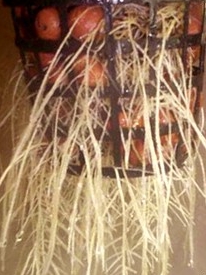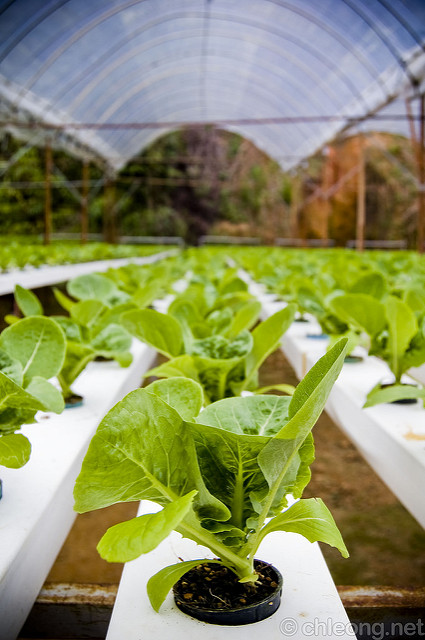Nutrient Film Technique, continued
This is page 4 of our twelve page series on nutrient film technique. Click any of the below pages to jump to that page.
Page 1 Page 2 Page 3 Page 4 Page 5 Page 6 Page 7 Page 8 Page 9 Page 10 Page 11 Page 12
 |
 |
Two close-up looks at NFT pots. The photo on the left, courtesy of www.RGJHydroponics.weebly.com, shows a standard net pot with plant roots growing through the pot. Those roots dangle down into the nutrient solution which flows through the channel. On the right, courtesy of www.Chleong.net, shows a closeup look at how the net pot fits into the lid of the channel. That ensures the plant doesn't sit down in the nutrient solution and become waterlogged.
What Growing Media Is Used in Nutrient Film Technique?
Nutrient Film Technique is something of an oddity regarding growing media. It could even be called a hybrid system in some regards. The initial seed definitely needs growing media of some kind, and that will be determined by the size of the seed. That media will also, at least in part, be determined by the size and mesh type for the net pot which the plant will eventually inhabit. As we’ve already discussed, net pots work well with rockwool cubes, rockwool croutons and hydroton. Sand, gravel, perlite/vermiculite, and coir are all too finely textured for net pots, and would pass right through the mesh. Lava rock, in turn, is too big and wouldn’t be able to keep the plant anchored.
Once the plant has germinated into that starter growing media, then it is placed into the net pot and the pot is placed into the NFT channel. From that point forward, no additional growing media is required. Thanks to this combination of secure germination and then open rooting encouragement, nutrient film technique is often considered one of the better, if not the best, hydroponics technique in terms of growing media efficiency. While this may not seem like a big deal, it matters in two different categories. First, any reduction in the amounts of necessary growing media will also reduce the overall cost of crop production. Secondly, some municipalities charge hefty fines for solid waste disposal. Given that most forms of growing media eventually need to be disposed of, disposal charges can start to matter for medium- and large-scale operations.
Having said all that, I should point out that each plant needs to be individually rooted and then transferred into a net pot. Each subsequent planting cycle repeats the need for growing media and net pots. Depending on the crop, that might only be once/year, yet some short-term crops such as lettuce might even have monthly plantings. Given all that, there is a temptation to recycle as much of the production materials as possible. Is that possible and/or practical?
The net pots can definitely be recycled, for at least several years. Many producers will just brush them off and reuse them. A better practice is to either soak them or spray them with a bleach solution to kill any potential disease organisms. Failing to do that can result in a buildup of disease organisms in your system, which after a few years may prove difficult to eradicate.
Can the growing media by recycled in nutrient film technique systems? It depends on which media is used. Rockwool is generally regarded as a single-use product, to be discarded after use. Some crops make re-use very difficult because they put out so many roots into the cube. Even after harvest and/or plant death, those roots are difficult to remove. Furthermore, they start to tear apart the cube itself, particularly if you try to remove them. Finally, they will eventually begin to break down and rot. If the cubes are reused, the old roots would be rotting away while tender young shoots were trying to get started. While that is not a guarantee of disease, it’s sure a fertile incubator for problems. If the previous plants haven’t put too many roots into the cube, or you’re using croutons which seem unaffected by the previous crop, you can try to reuse them. I’d strongly recommend doing so on a limited basis at first to see how it goes. In other words, don’t stake an entire crop worth of production on the hopes that your rockwool will be OK the second time around. To boost your chances of success, try soaking the rockwool in a bleach solution then rinse well prior to using again.
Hydroton is a growing medium which some people will use only once, and others will use over and over again. Different methods have been advocated for either washing/rinsing or flat out sterilizing hydroton pellets in between crops. Some of those methods include a wash/rinse in a bleach solution, to kill any undesirable biological organisms. A second method involves setting out the hydroton pellets in full sun on a screen or shallow edged table. The theory there is that the sun will simultaneously dry out the hydroton and dessicate any undesirable biological organisms, and the UV light would provide a home-grown version of sterilization. I’ve even seen mention of some growers running their hydroton through a UV sterilization cycle. I would think this approach would be cost prohibitive for any but the largest hydroponic operations. However, UV sterilization units have come down in both price and size in recent years. I intend to do some research on that particular topic in the near future, and I’ll report back here with whatever I find.
Back Next
Click any of the below links to jump to that page.
Page 1 Page 2 Page 3 Page 4 Page 5 Page 6 Page 7 Page 8 Page 9 Page 10 Page 11 Page 12